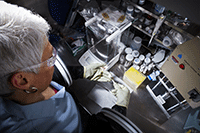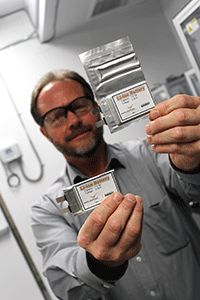Energy Storage for Electric Vehicles
Developing better batteries for the advancement of electric vehicles

Lithium (Li) ion batteries are the most promising energy storage technology for electrical vehicles (EVs). They can help reduce environment pollution and ensure energy security in the United States. However, the large-scale market penetration of EVs has been hindered by several barriers, including limited energy density, high cost and thermal instability related safety concerns of cathode in Li ion batteries.
At PNNL, our energy storage program for transportation applications aims to develop low-cost, high-energy electrode materials and electrolyte that will enable Li ion batteries to have a long life and low cost while operating safely for long-range EVs.
We are also exploring the next generation of energy systems beyond Li ion batteries—which includes Li-sulfur batteries, Li air batteries, and other Li metal batteries. Various in situ and ex situ microscopic characterization technologies will be used to investigate the fundamental failure mechanism in the electrodes and electrolyte as well as their interface properties.
Equipment and Facilities

We have a 5,000 square foot facility on our campus that contains advanced battery research equipment. This space includes the newly established Advanced Battery Facility, which consists of a dry room and semi-automatic system for film casting and pouch-cell assembly, as well as a room for powder handling and mixing.
Battery preparation equipment available at our facilities includes eight argon-filled glove boxes, six coin-cell crimpers, roll laminators, platen presses, screen printers, particle size analyzers, various furnaces, and several high energy and planetary mills used for mechanical processing of particles. Electrochemical testing equipment includes more than 1,000 channels of battery testers, one high precision battery tester, one high-power battery tester with BTS firing circuits at 50A/36V or 100A/36V, multiple potentiostats, frequency response analyzers, and lock-in amplifiers.
PNNL also has advanced diagnostic instruments which are critical for fundamental understanding of material properties. These instruments include TEM, SEM, AFM, XPS, XRD, ultra-high-field NMR (900 MHz) spectrometer etc. for in situ and ex situ characterization of electrode and electrolyte materials.
Publications
- "Highly Stable Operation of Lithium Metal Batteries Enabled by the Formation of a Transient High-Concentration Electrolyte Layer," Jianming Zheng, Pengfei Yan, Donghai Mei, Mark H. Engelhard, Samuel S. Cartmell, Bryant J. Polzin, Chongmin Wang, Ji-Guang Zhang, and Wu Xu, Adv. Energy Mater 6,8. April 2016.
- "High Performance Li-ion Sulfur Batteries Enabled by Intercalation Chemistry," Dongping Lv, Pengfei Yan, Yuyan Shao, Qiuyan Li, Seth Ferrara, Huilin Pan, Gordon L. Graff, Bryant Polzin, Chongmin Wang, Ji-Guang Zhang, Jun Liu, and Jie Xiao. J. Chemical Communications. July 2015, DOI: 10.1039/c5cc05171a.
- "High Rate Cycling of Stable Lithium Metal Anode," Jiangfeng Qian, Wesley A. Henderson, Wu Xu, Priyanka Bhattacharya, Mark Engelhard, Oleg Borodin, Ji-Guang Zhang. Nature Communications, 6:6362. February 2015, DOI: 10.1038/ncomms7362.
- "In Situ Transmission Electron Microscopy Probing of Native Oxide and Artificial Layers on Silicon Nanoparticles for Lithium Ion Batteries," Yang He, Daniela Molina Piper, MengGu, Jonathan J. Travis, Steven M. George, Se-Hee Lee, Arda Genc, Lee Pullan, Jun Liu, Scott X. Mao, Ji-Guang Zhang, Chunmei Ban, and Chongmin Wang. ACS Nano, 8,11. October 2014.
- "Mesoporous Silicon Sponge as an Anti-Pulverization Structure for High-Performance Lithium-Ion Battery Anodes," Xiaolin Li, Meng Gu, Shenyang Hu, Rhiannon Kennard, Pengfei Yan, Xilin Chen, Chongmin Wang, Michael J. Sailor, Ji-Guang Zhang, Jun Liu, Nature Communications 5,4105. May 2014, DOI:10.1038/ncomms5105
- "Mitigating Voltage Fade in Cathode Materials by Improving Atomic Level Uniformity of Elemental Distribution", Jianming Zheng, Meng Gu, Arda Genc, Jie Xiao, Pinghong Xu, Xilin Chen, Zihua Zhu, Wenbo Zhao, Lee Pullan, Chongmin Wang, and Ji-Guang Zhang. Nano Lett. 14,5. April 2014, DOI: 10.1021/nl500486y.
